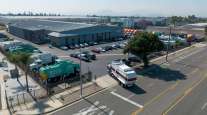YRC Worldwide, Arkansas Best Report Losses, but First Quarter Is Brighter for Other LTLs
This story appears in the May 7 print edition of Transport Topics.
YRC Worldwide Inc. and Arkansas Best Corp.’s less-than-truckload unit reported losses in the first quarter, although three other major carriers reported marked improvement during the period.
Con-way Inc. on May 1 said net income more than tripled, rising to $25.6 million from $6.9 million a year earlier, including a 70% rise in LTL operating income. Saia Inc. raised its earnings even faster — to $5.5 million from $713,000, improving operating income to $9.2 million from $1.2 million. Also on the plus side, Roadrunner Transportation Systems Inc. increased net income by 80% to $7.9 million, with help from acquisitions and truckload growth as well as LTL.
YRC on May 3 said it trimmed its quarterly loss to $81.6 million, compared with $102.7 million the year before, including an operating loss of $48.8 million. Arkansas Best’s net loss was $18.2 million, with a trucking operating loss of $22 million.
“It was a very interesting first quarter,” said Satish Jindel, who heads SJ Consulting, noting the wide disparity in industry results evidenced by the best operating ratio of 89.1 at Old Dominion Freight Lines and the worst, 105.5, at Arkansas Best’s ABF Freight System.
“The economy should have had the same benefit for everyone,” Jindel told TT. “The weather benefit from a nice mild winter also should be same for all. With demand fairly sound, that makes for a good environment to improve profit.”
The difference between the companies, Jindel said, was effective management at Old Dominion and high costs at ABF.
ABF lost money despite an industry leading revenue per shipment of $367 that was nearly 40% higher than Old Dominion, the next best, at $267.
Arkansas Best’s revenue rose less than 1% to $440.9 million, including the same proportional gain at ABF to $400.6 million. While rates rose more than 11%, tonnage per day slipped by a nearly identical amount.
“ABF should swing back to profitability in the second quarter,” said an April 30 report from Wolfe Trahan, with help from tonnage improvement to April from March that was the best in 20 years and a pattern of improved results from the first to the second quarter.
Results were more favorable at Con-way, whose LTL operating ratio improved to 95.8 from 97.4, at Saia with a 2.4 percentage point improvement to 95.9 and for Roadrunner, whose LTL operating ratio also was better at 92.9 versus 95.2 a year earlier.
By individual company, Con-way increased corporate revenue to $1.37 billion, nearly 10% above the year earlier, and also reported higher profits at its truckload and logistics units. Both truckload and logistics operating income rose more than 40%. Truckload revenue rose 8% to $157.3 million, and logistics revenue climbed to $419.1 million.
Next in line by revenue was YRC, where revenue rose 6.3% to $1.19 billion. Revenue at the national LTL business rose to $789.1 million, but the operating loss widened to $56.1 million.
Results at YRC’s regional business were better, with revenue rising nearly 10% to $402 million and operating income of $11.4 million, compared with a $1.2 million loss on that basis the year before.
YRC regional tonnage rose 6%, and national unit tonnage climbed 3.5%.
Saia raised revenue 11% to $269 million, helped by 7.9% higher revenue per 100 pounds of freight.
Roadrunner boosted LTL tonnage by 11% and revenue per hundred pounds of freight by 6.2%, producing an 18% rise in revenue from that business. Overall, revenue rose 38% at Roadrunner to $236.6 million, including 80% growth in the truckload business after three acquisitions.
Jindel also said that private carriers surveyed by his firm in general had better operating ratios than the publicly traded companies, including a handful of carriers that matched or were close to Old Dominion’s 89.1 achievement. Old Dominion’s operating income was $51.4 million.
The publicly traded carriers’ operating ratio as a group was 98.4.
Other publicly traded LTL carriers struggled, with a wider loss at Vitran Inc., whose operating ratio worsened to 102.7.




